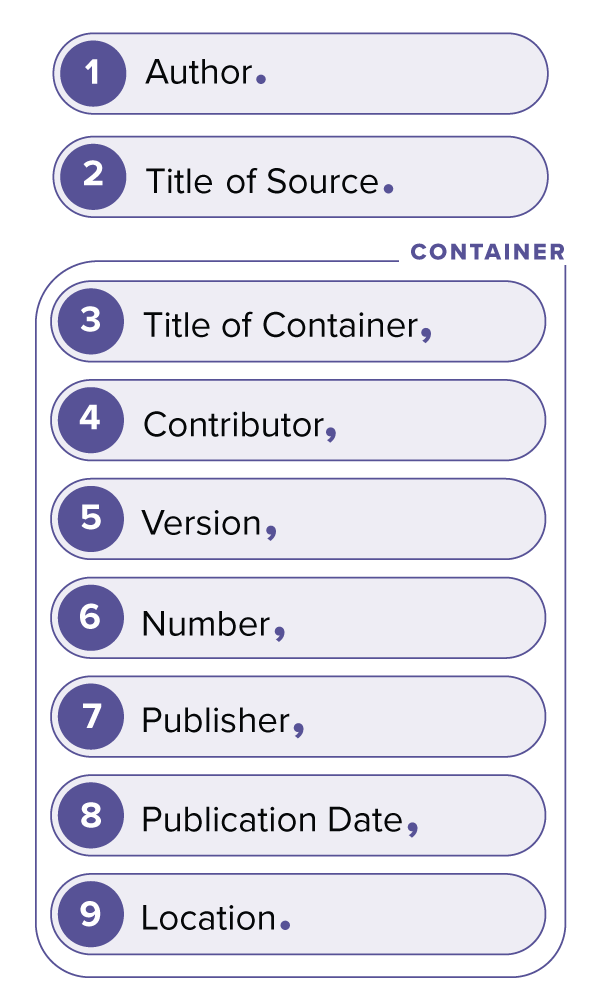
Thought Lab 2
- Home
- Doing Research and Finding Sources Toggle Dropdown
- Citations
- Annotations and Evaluating Sources Guide This link opens in a new window
- Information Literacy Guide This link opens in a new window
- Need Help?
-
Purdue OWL
 The Purdue Online Writing Lab (OWL) is a great resource for information and guidance on writing MLA-style citations.
The Purdue Online Writing Lab (OWL) is a great resource for information and guidance on writing MLA-style citations.
Citations
Write your citations in the MLA 9th edition style. This style requires in-text citations and a Works Cited Page.
(Unless your professor requires that you use a different style; always defer to an assignment's requirements.)
Elements
MLA citations assemble facts about a source, like who wrote it and when it was published. These facts are known as elements.
Quick Rules
- Each element should be followed by the appropriate punctuation mark, either a comma or a period, depending on where it is in the citation.
- If the information for an element cannot be found or does not apply to the source, omit that element.
- Entries should always conclude with a period.
Core Elements
All MLA citations will follow a template of applicable core elements: author, title of source, container of source, contributor(s), version, number, publisher, date, and location. If you are missing information to supply any of the core elements, skip that element.
For detailed information about each of the core elements, click here.

Image: Modern Language Association. "Works Cited: A Quick Guide." MLA Style Center, https://style.mla.org/works-cited/works-cited-a-quick-guide/. Accessed 6 Jan. 2023.
Supplemental Elements
Sometimes, you might choose to include supplemental information about a source. Supplemental information will typically be inserted after the title of the source or at the end of the citation, with a period after the information.
See here for more information about incorporating supplemental elements.
General MLA Citation Template
Author's Last Name, First Name. Title of Book: Subtitle. Supplemental Elements. Title of 1st Container, Contributor, Version or edition, Number, Publisher Name, Publication Date, Pages. Title of 2nd Container, Contributor, Version or edition, Number, Publisher Name, Publication Date, Pages. Supplemental Elements.
The layout and necessary elements will vary depending on the source you're citing. You do not need to use all of these elements for every source, just those that are relevant. See "How do I cite..." for more specific formatting.
Want to practice? Check out the MLA Style Guide's "Interactive Practice Template"
"How do I cite..."*
- Advertisements
- Artworks or artifacts
- Books or eBooks
- Course materials (e.g., class notes, presentations, etc.)
- Encyclopedias or dictionaries
- Generative AI (updated September 16, 2025)
- Government documents
- Images, charts, graphs, or tables
- Journal articles
- Magazine articles
- New Media (e.g., podcasts, blogs, internet videos, social media, etc.)
- Newspaper articles
- Personal communications (e.g., interviews, emails, etc.)
- Religious texts
- Theses or dissertations
- Videos or DVDs
- Websites
- Works quoted in another source
*Within each section, you will see more specific categories and circumstances (e.g., articles found in print vs. through a library database).
- Last Updated: Oct 31, 2025 1:23 PM
- URL: https://otis.libguides.com/thought_lab_2
- Print Page
Otis College of Art and Design | 9045 Lincoln Blvd. Los Angeles, CA 90045 | MyOtis
Millard Sheets Library | MyOtis | 310-665-6930 | Ask a Librarian